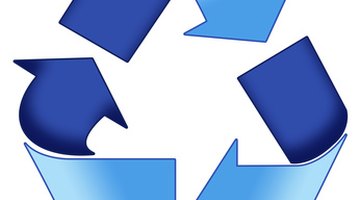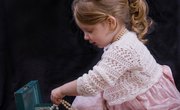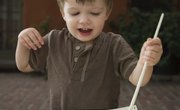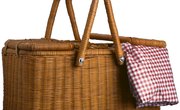Recycling prevents excess pollution, helps conserve valuable resources such as trees and fresh water, and decreases the need for extra energy consumption. Although young children may not be ready to appreciate the intricacies of the environmental impact that recycling holds, they can understand the basics. Help teach kindergartners about why recycling is important and how it can be done using a variety of interactive educational activities in classroom learning centers.
Arts and Crafts with Recycled Items
Instead of spending extra money on fancy art materials, try a budget-friendly recycling craft project in your kindergarten classroom. Instead of using construction paper or oak tag paper, cut large moving or packing boxes into small square- or rectangle-shaped pieces. Give the students a variety of different recycled materials to choose from such as paper scraps, cut-up egg cartons, plastic bottle caps, yarn scraps and fabric scraps. Have the students glue the items to the cardboard in a collage style. Keep recycling throughout the school year by saving small, cut-up parts of paper and other art materials to reuse in new projects.
Build With Recycled Items
Create a recycled construction learning center by collecting and reusing objects and items such as soda bottles, milk cartons, cardboard boxes and fabric scraps from old clothes. Make sure all items are thoroughly cleaned and fully dried before reusing. Place the items on shelves, in a large bin or a recycled moving box. Set out tape, glue, markers, paints and crayons for students to use with the materials. Encourage the kindergartners to explore the recycled items, creating their own constructions. Make a box city, cardboard car or any other project by attaching the materials together with tape and glue. Use the markers, paints and crayons to add special features and/or designs.
Recycling Printables and Coloring Sheets
Download and print recycling theme coloring and activity sheets to use in a kindergarten recycling learning center. Click the "ABC Teach," "Apples for the Teacher" or "Color Me Good" links in the Resources section for free printable recycling pages. Instead of printing out the pages on new paper, reuse the backs of old flyers, other worksheets or other similar papers to help the children better understand recycling. Print coloring pages and color the recycling signs to hang over a school bin, an Earth picture to display in the classroom or a recycling symbol for the recycling center.
Sorting and Classifying Recycling Activities
Help your kindergarten students understand what can be recycled and how. Send a letter home to parents asking them to donate used plastic, paper and aluminum items. Make sure to provide clear instructions for proper cleaning and drying of the items. Use items from classroom if you want to avoid asking parents for donations. Have the students save milk cartons, empty juice boxes/pouches, plastic bottles or brown paper lunch bags from meal or snack time. Bring the various items to a table. Get three large bins or buckets and invite the students to sort each item by paper, plastic or aluminum. When you have finished sorting the items, read the students a non-fiction book or even a picture book about how recycling works.
Related Articles
Writer Bio
Based in Pittsburgh, Erica Loop has been writing education, child development and parenting articles since 2009. Her articles have appeared in "Pittsburgh Parent Magazine" and the website PBS Parents. She has a Master of Science in applied developmental psychology from the University of Pittsburgh's School of Education.











